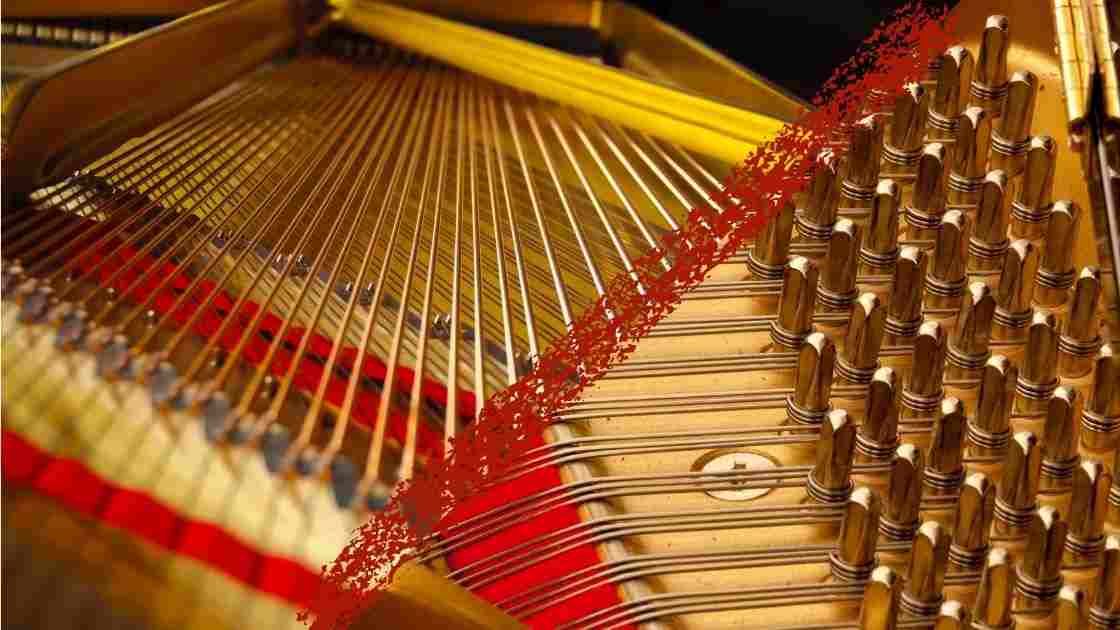The piano is a fascinating instrument renowned for its versatility and rich tonal qualities. One key component contributing to its unique sound is the array of strings within its frame. How many strings does a piano have?
In this article, we’ll share the details to help you understand the number of strings in a piano. Their arrangement provides insight into how this instrument produces its broad range of pitches.
Table of Contents
How Many Strings Does a Piano Have?
A standard modern piano typically has between 220 and 230 strings. The exact number can vary slightly depending on the specific make and model of the piano.
It is worth to note that only acoustic pianos have strings. They are an essential component of the instrument, responsible for producing its rich and varied tones.
Digital pianos or electric keyboards do not have the similar mechanisum. Their sounds are generated digitally.
These strings are divided among the 88 keys of the piano, though not in a one-to-one correspondence.
Here’s a closer look at the distribution of these strings.
Bass Section
The lowest notes on the piano, usually the first 8 to 10 keys on the left side, have single string per key.
These strings are thicker and longer to produce the deep, resonant sounds characteristic of the bass register.
Middle Range
Moving up the keyboard, the next range of notes often has two strings per key.
This range typically covers the piano’s lower to mid-register and includes approximately 15 to 20 notes. The use of two strings helps to enrich the sound, providing a fuller tone.
Treble Range
The higher notes, encompassing the majority of the piano’s range, generally have three strings per key.
This section includes the remaining keys, often from the mid to upper register, accounting for the majority of the strings. The triple-string arrangement in the treble range ensures a bright, rich sound with greater volume and sustain.
Why Different Numbers of Strings?

The varying number of strings per key serves several purposes:
- Sound Quality: More strings create a fuller and more resonant sound. Single strings in the bass produce powerful, deep tones, while multiple strings in the higher ranges produce clear, bright notes.
- Volume and Sustain: Multiple strings increase the volume and sustain of the notes, allowing the piano to project more effectively in a concert hall setting.
- Tonal Balance: This arrangement helps to balance the tonal qualities across the entire range of the piano, ensuring that no single register dominates the overall sound.
String Materials and Tuning
Piano strings are high-tensile steel to withstand the significant tension they are under.
The bass strings are often wound with copper to increase their mass without requiring excessive length, which helps in producing the lower pitches.
Tuning a piano is a meticulous process, as each string must be adjusted to the precise tension needed to produce the correct pitch. The piano’s tuning pins, bridge, and soundboard all play crucial roles in maintaining the stability and quality of the instrument’s sound.
Are Piano Strings Dangerous?
The strings in piano are under extremely high tension. Each string is typically stretched with a tension of around 160 to 200 pounds (73 to 91 kilograms). The combined tension of all the strings in a piano can exceed 18 tons. This immense tension is necessary for the strings to produce the correct pitches and sustain the sound.
If a string breaks, the sudden release of tension can cause the string to snap violently. This can result in sharp, whipping movements that pose a risk of injury to anyone nearby.
While such incidents are rare, they can happen, particularly if the strings are old, rusty, or not properly maintained.
For this potential hazard, piano technicians handle the strings very carefully. For example, during a restring of piano, a technician will loosen the strings a little bit for all the strings, then go several rounds. They will never loosen any string quickly.
Therefore, proper maintenance and professional handling strings will significantly reduce the risks.
Historical Perspective
Historically, the number of strings in pianos has evolved.
Early pianos, such as those made by piano inventor, Bartolomeo Cristofori, in the early 18th century, had fewer strings and a different arrangement compared to modern instruments.
As the piano evolved, innovations in design and materials allowed for more strings and a greater range of notes, leading to the modern piano’s configuration.
How Much do Piano Strings Cost?

The strings are a crucial component of the instrument, and their replacement or purchase costs can vary based on several factors, including
- the type of piano.
- the quality of the strings,
- buying individual strings or a complete set.
Individual String Costs
- Standard Strings: Individual piano strings typically cost between $2 to $5 each. The price can vary depending on the string’s length, gauge, and manufacturer.
- Bass Strings: Bass strings are usually more expensive than standard treble strings because they are longer and wound with copper. These can range from $20 to $30 per string.
Complete Sets
- Upright Piano: A complete set of strings for an upright piano can cost between $200 to $400. This includes all the treble and bass strings needed for the entire instrument.
- Grand Piano: For a grand piano, the cost of a complete set of strings is generally higher, ranging from $250 to $600, due to the larger size and greater number of strings.
Additional Costs
Replacing piano strings is a complex task that typically requires the expertise of a professional piano technician.
The cost for labor can vary widely based on location and the technician’s experience but expect to pay between $1,000 to $2,500 for a complete restringing job. This includes the cost of the strings and the labor involved in the meticulous process of replacing them.
For a grand pianos, the cost can be even higher.
After replacing strings, the instrument will need to be tuned multiple times as the new strings stretch and settle. Each tuning session can cost between $100 and $200.
Factors Affecting Cost
- Quality: Higher-quality strings made from premium materials will cost more but may offer better sound quality and durability.
- Brand: Well-known brands like Mapes, Roslau, and Paulello tend to be more expensive but are often preferred by professionals for their reliability and sound.
- Piano Type: The type and model of the instrument also influence the cost, with larger grand pianos generally requiring more expensive sets of strings.
Conclusion
The intricate design of the piano’s string arrangement is a testament to centuries of musical innovation.
With between 220 and 230 strings carefully distributed among its 88 keys, the modern piano is capable of producing a wide spectrum of sounds, from the thunderous lows to the sparkling highs.
This complexity is what makes the piano such a beloved and versatile instrument in both classical and contemporary music. Understanding the role of these strings helps us appreciate the engineering marvel that lies within every piano.
Related Articles:

